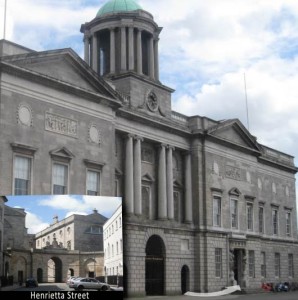Registry of Deeds
If your ancestor leased land in Ireland, even a small plot of 20 acres, you may find evidence of them in the Registry of Deeds. As leases can sometimes state the names of the children of the tenant, these records, which date from 1708, could prove to be a boon to your Irish family history research.** The Registry of Deeds is currently closed and there is no date set for reopening.
About the Registry of Deeds
The Registry of Deeds was established in 1708 and is the repository for memorials of deeds and conveyances representing transfers of property in Ireland. It was not compulsory to register deeds or conveyances with the Registry, so their records are not a comprehensive account of all land transactions in the country. The Registry of Deeds can be useful for genealogical research because deeds and conveyances can sometimes contain valuable genealogical information, such as names, occupations and addresses for the parties to the deeds as well as family relationships, maiden names of wives and the names of siblings and the married names of sisters. Marriage settlements or the distribution of an estate based on the instructions of a will (which may no longer survive), can contain a great deal of genealogical information. Not all families will have registered transfers of property with the Registry of Deeds, so this source is really only useful for researching families who were in possession of property in Ireland in the 18th and 19th century.Using the Indexes in the Registry of Deeds: Surname and Placename Index
Records in the Registry of Deeds are indexed in two ways. There is a Surname Index and Placename Index. The Surname Index is organised by the name of the Grantor, the person who disposed of the property. If you are looking for a memorial of a deed of lease for someone who was a tenant, you will need to search the Surname Index under the name of the person from whom they leased the land. In the earliest index books the Surname Index recorded the name of the Grantor, the name of the Grantee and the reference number for the memorial, which identifies the number or year of the book, the page and the number of the memorial. Later books can contain more detail such as the location of the property. The Land Index is an alphabetical list of townlands, arranged by Barony and then by County. If you intend to search the Land Index, you should make sure you know the Barony and County in which the property is located. Once you find a reference to the townland you are interested in, the index records the names of the two parties, grantor and grantee and a reference to the memorial.The National Library of Ireland hold copies of the Indexes on microfilm, although the microfilm copies can sometimes be difficult to decipher. Once you have identified the references to the memorials that pertain to the land or family you are interested in, you can consult the book of memorials pertaining to the year that you are interested in. The memorial is a transcript of the terms of the original deed or conveyance and can often refer to earlier leases made for a property.
Both the Land Indexes and the Surname Indexes can be found on the top floor of the Registry of Deeds, but in different rooms. There is usually a guide posted at the entrance to each research room indicating where the various indexes and memorial books are found.
Research in the Registry of Deeds can be time consuming and the memorials contain a great deal of legal language. Trying to extract relevant genealogical information from a deed can be challenging, but in many cases worthwhile.
The Church of the Latter Day Saints Family History Library have now published images of their microfilm copies of records in the Registry of Deeds online. You can also find abstracts from the Registry of Deeds published online at Registry of Deeds Indexing Project Ireland. This is a constantly growing collection so worth returning to again and again.
Registry of Deeds Location & Opening hours
 The Registry of Deeds is located at the top of Henrietta Street in Dublin.
The Registry of Deeds is located at the top of Henrietta Street in Dublin. You must go through the archway at the top of the street and then enter the building on your left.
The staff will ask you to sign in and place your belongings in a locker.
No mobile phones (with cameras) or cameras are permitted beyond the lobby.
You will be given an electronic card that will allow you to enter the various research rooms, which are all located on the top floor of the building.
Facilities
There are limited electrical outlets and the research desks are not designed for laptops, but you will be compensated when the large vellum books transport you back to the 18th century as you gaze out over the city from the windows of one of the research rooms.
Fees
There are no fees to consult the records held in the Registry of Deeds unless you want copies of material, which can be ordered at the same counter where you obtained your electronic card. Copies of a memorial cost €20.00. Research in the Registry of Deeds is extremely time consuming. If you intend to use this repository make sure you give yourself enough time, at least half a day, to undertake your research. For more information visit the Registry of Deeds website
Registry of Deeds
Henrietta Street
Dublin
Dublin 1
Ireland
Dublin
Dublin 1
Ireland
Email Address
[email protected]
Opening Hours
